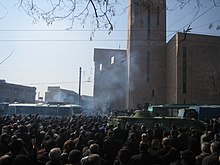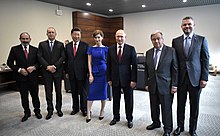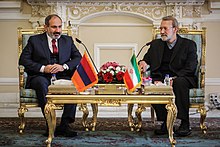Nikol Pashinyan
[7] Pashinyan's new government included multiple liberal western NGO activists being appointed to senior positions,[8] as well as supporters from the Velvet Revolution who had no previous political experience.
The war, which was ended after 44 days of fighting by a trilateral ceasefire agreement signed by Pashinyan on 9 November 2020, resulted in significant human, material and territorial losses for the Armenian side.
Pashinyan claimed it was an attack perpetrated by Gagik Tsarukyan, an oligarch and MP close to president Robert Kocharyan who was deputy chairman of the Armenian Olympic Committee (AOC).
[42][43] The primary policy goal of the bloc was impeaching President Robert Kocharyan,[44] but also ousting Prime Minister Serzh Sargsyan and oligarch Gagik Tsarukyan from power.
"[71] Thomas Hammarberg, Council of Europe Commissioner for Human Rights, noted that the Prosecutor General's office used a "detailed expert analysis of the linguistic and psychological aspects of Mr Pashinyan's speech had been performed, and that this was instrumental in proving his role in organising the mass disorders.
"[101] Parliamentary Assembly of the Council of Europe (PACE) co-rapporteurs for Armenia, John Prescott and Axel Fischer stated in their 2011 report Pashinyan's "continued detention is also highly problematic."
"[102] In December 2010 dozens of members of the Armenian National Academy of Sciences, a generally pro-government establishment organization, signed a letter calling for Pashinyan's release.
[128] Pashinyan speaking at a rally for the first time since the 1 March 2008 events declared, "From today on we start a political process in favour of early presidential and parliamentary elections, because only they may return people's faith in its future.
[144] In November 2014 he announced his plans to start an impeachment process against Serzh Sargsyan to contribute to the "fulfillment of the trio's pledge to end the ‘heated political autumn’ with regime change.
The statement said that "Tens of thousands of citizens were involved in the chain of vote bribe distribution and acceptance and there is an atmosphere of public tolerance towards that phenomenon, which is a time bomb planted under Armenian statehood."
[190] After Sargsyan was elected prime minister, Pashinyan moved the main protest site to Yerevan's Republic Square where he declared the beginning of a "non-violent, velvet, popular revolution" in Armenia.
[220] On the sidelines of the CIS summit in Dushanbe on 27 September 2018, Pashinyan met Azerbaijani President Ilham Aliyev and reached an agreement to instruct their defense ministers to take steps to de-escalate the situation at the Azerbaijani-Armenian border.
For example, Pashinyan's English teacher Lilit Makunts,[10] who had no political experience prior to the Velvet Revolution, was appointed Minister of Culture and later Ambassador to the United States.
[226] After an Armenian court ordered Kocharyan's release from imprisonment in May 2019, Pashinyan openly accused Armenia's judicial system of corruption and collaboration with representatives of the old regime.
Pashinyan called on his supporters to block court buildings and announced his plan to introduce mandatory "vetting" for all judges to investigate possible corruption and links to the old regime.
[238] Hetq journalist Edik Baghdasaryan had criticized Pashinyan's government for doing nothing to prepare for the war despite it being known Azerbaijani troops had been gathering along the border several months before their attack.
Kocharyan's party disputed the election results and accused Pashinyan of electoral fraud, stating, "Hundreds of signals from polling stations testifying to organised and planned falsifications serve as a serious reason for lack of trust".
[272] During an 8 June 2021 speech for the upcoming Armenian parliamentary election, Pashinyan brandished a hammer around while threatening to "throw on the ground" and "bang against the wall" opposition supporters.
In 2002, Pashinyan's Haykakan Zhamanak reprinted Levon Ter-Petrosyan's 1997 article titled "War or Peace" in which the latter argued for a compromised solution in the Karabakh conflict, which would include loss of control by Armenian forces of several occupied/liberated territories of Azerbaijan.
[277] During the 2008 Armenian presidential election protests, Pashinyan could be heard telling protestors, "we must liberate our city from the Karabakhtsi scum", in reference to Robert Kocharyan and Serzh Sargsyan.
"[258] Political scientist Simon Saradzhyan noted that no matter his personal views, Pashinyan realizes that Armenia has "no viable alternative but Russia as its guarantor of security, while it faces two hostile bordering states, Azerbaijan and Turkey.
In the long term, the European Union and Armenia are determined to strengthen their economic ties by working to unlock the full potential of the Comprehensive and Enhanced Partnership Agreement.
"[312] Nonetheless, the Way Out Alliance parliamentary faction approved a draft statement by the parliament demanding the government to start a process of invalidating Armenia's accession treaty with the EEU.
Pashinyan stated, "Moscow has been unable to deliver and is in the process of winding down its role in the wider South Caucasus region" and "the Russian Federation cannot meet Armenia's security needs.
"[2] Pashinyan's Haykakan Zhamanak supported the normalization process that then-President Serzh Sargsyan and Turkish President Abdullah Gül initiated, however, he criticized the "government's way of pursuing it.
[332] Vartan Oskanian, the former Foreign Minister of Armenia, criticized Pashinyan for attending the inauguration despite Erdogan frequently insulting Armenians and supporting Azerbaijan in the Nagorno-Karabakh conflict.
"[340] On 20 July night Pashinyan intervened and successfully prevented further clashes after more than 50 supporters of the gunmen were injured by government forces during an attempt to approach the seized police station.
He declared, "The highest meaning of the existence of the Republic of Armenia is the centralization of human, financial, intellectual and economic potential of Armenians on their historic territory and ensuring their security.
"[369] Former Chief of Armenian Armed Forces Onik Gasparyan wrote in an article directed at Pashinyan, "I know that you are the greatest master of cheap shows, and that you cover up the absolute inability to govern the state by feeding the society baseless emotional statements".
"[372] Emil Sanamyan suggested that the revolution saw Pashinyan "transform from a lonely Don Quixote figure into a warrior-like Santa who managed to 'rescue' Armenia from a corrupt regime.



















